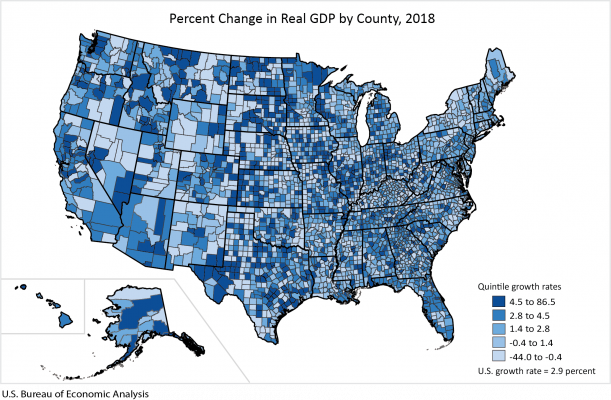
Real gross domestic product (GDP) increased in 2,375 counties, decreased in 717, and was unchanged in 21 in 2018, according to estimates released today by the U.S. Bureau of Economic Analysis (BEA). The percentage change in real GDP ranged from 86.5 percent in Jackson County, WV, to -44.0 percent in Grant County, ND.
GDP is the value of goods and services produced within a county. The size of a county’s economy as measured by GDP varies considerably across the United States. In 2018, the total level of real GDP ranged from $18.4 million in Issaquena County, MS, to $710.9 billion in Los Angeles County, CA.
Highlights
Large Counties: 141 counties with populations greater than 500,000 in 2018
- Real GDP increased in 136 and decreased in 5.
- GDP ranged from $11.2 billion in Pasco County, FL, to $710.9 billion dollars in Los Angeles County, CA.
- Santa Clara County, CA, (10.2 percent) was the fastest growing large county. The information industry was the leading contributor to the county’s growth.
- Kern County, CA, (-0.7 percent) had the largest percentage decrease in GDP. The mining, quarrying, and oil and gas extraction industry (primarily oil and gas extraction) was the leading contributor to the decrease
Medium Counties: 464 counties with populations between 100,000 and 500,000 in 2018
- Real GDP increased in 433, decreased in 30, and was unchanged in 1.
- GDP ranged from $2.0 billion in Saline County, AR, to $52.6 billion dollars in Morris County, NJ.
- Canadian County, OK, (21.0 percent) was the fastest growing medium county. The mining, quarrying, and oil and gas extraction industry (primarily oil and gas extraction and support activities) was the leading contributor to the county’s growth.
- San Juan County, NM, (-6.1 percent) had the largest percentage decrease in GDP. The mining, quarrying, and oil and gas extraction industry (primarily non-oil and gas mineral extraction) was the leading contributor to the decrease.
Small Counties: 2,508 counties with populations less than 100,000 in 2018
- Real GDP increased in 1,806, decreased in 682, and was unchanged in 20.
- GDP ranged from $18.4 million in Issaquena County, MS, to $13.3 billion dollars in Karnes County, TX.
- Jackson County, WV, (86.5 percent) was the fastest growing small county. The construction industry was the leading contributor to the county’s growth.
- Grant County, ND, (-44.0 percent) had the largest percentage decrease in GDP. The agriculture, forestry, fishing, and hunting industry was the leading contributor to the decrease.
You can read more about economic indicators here.
Every five years the Census Bureau conducts an Economic Census and Census of Governments, in addition to more than 100 other surveys conducted monthly, quarterly, or annually.
BEA is an independent, principal federal statistical agency that promotes a better understanding of the U.S. economy by providing timely, relevant, and accurate economic accounts data in an objective and cost-effective manner.
Some of the widely used statistical measures produced by BEA include GDP, personal income and outlays, corporate profits, GDP by state and by metropolitan area, balance of payments, and GDP by industry. These statistics are used by federal, state, and local governments for budget development and projections; by the Federal Reserve for monetary policy; by the business sector for planning and investment; and by the American public to follow and understand the performance of the nation’s economy.


Chattooga Public Safety
Chattooga County: Most Recent Food Service Inspections

Chattooga Opinions
The Joy of the Journey: The Power of a Thankful Heart

Bulloch Public Safety
11/22/2024 Booking Report for Bulloch County

Bulloch Public Safety
11/04/2024 Booking Report for Bulloch County

Bulloch Public Safety
11/21/2024 Booking Report for Bulloch County

Bulloch Public Safety
10/28/2024 Booking Report for Bulloch County

Bulloch Public Safety
11/19/2024 Booking Report for Bulloch County

Bulloch Public Safety
11/07/2024 Booking Report for Bulloch County





